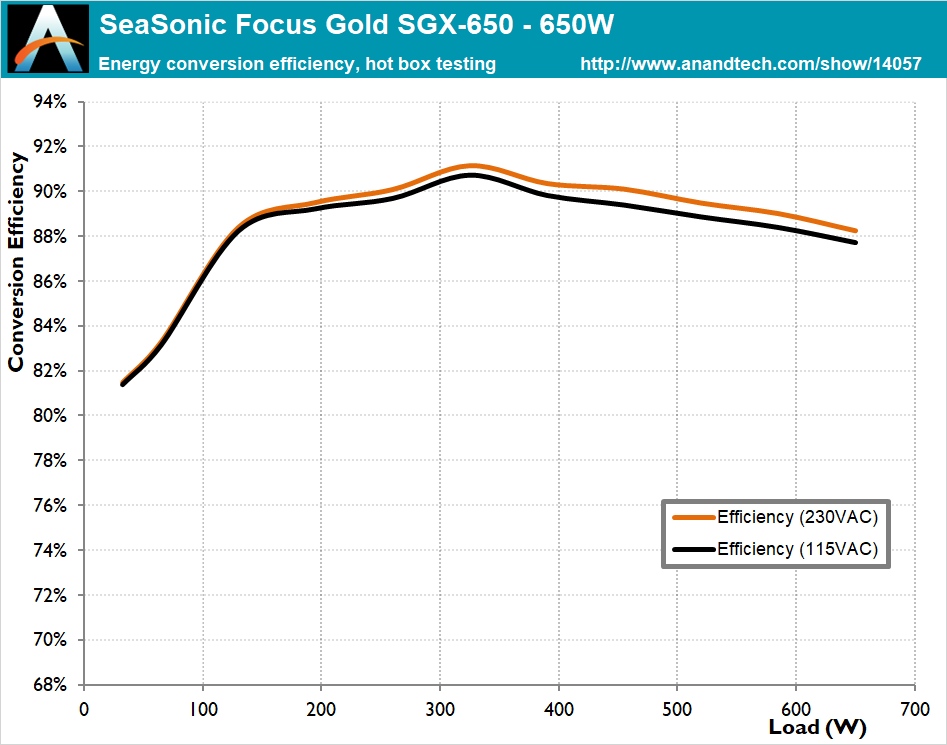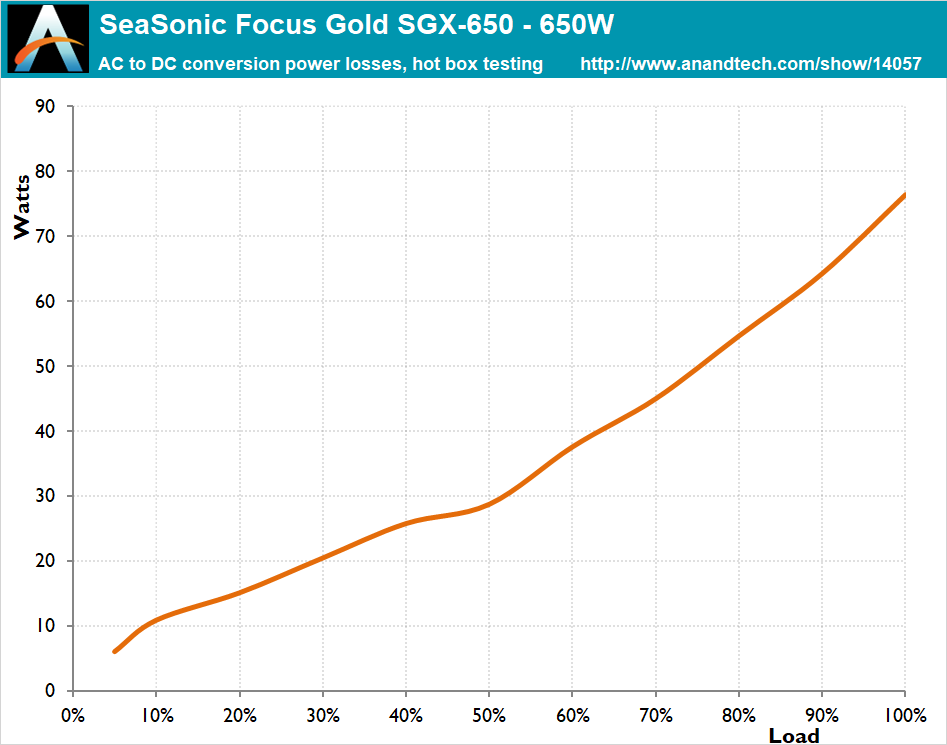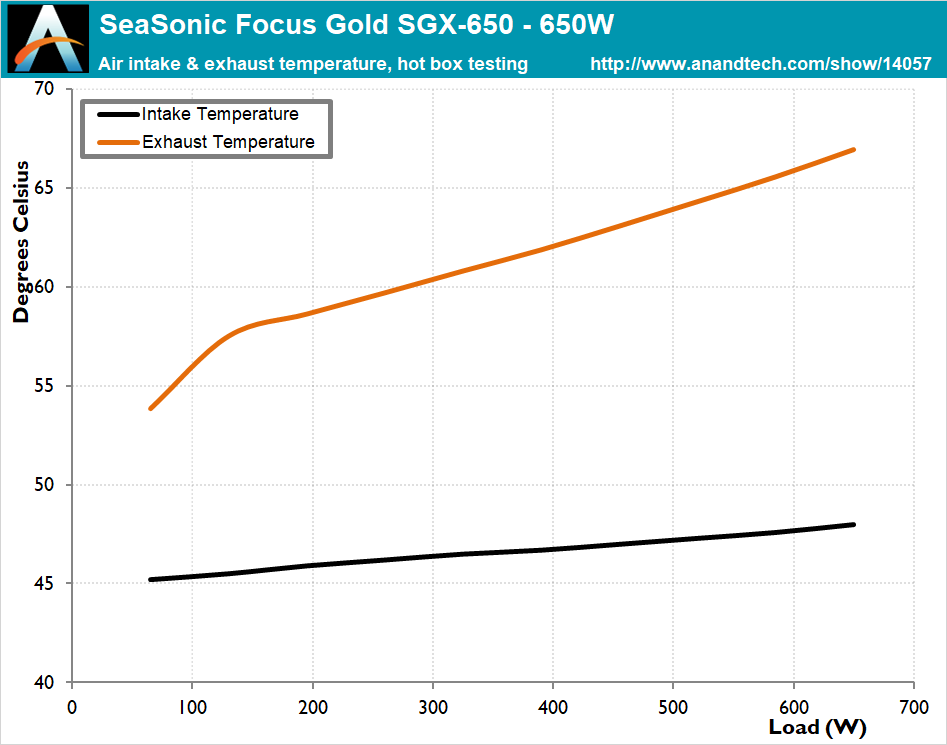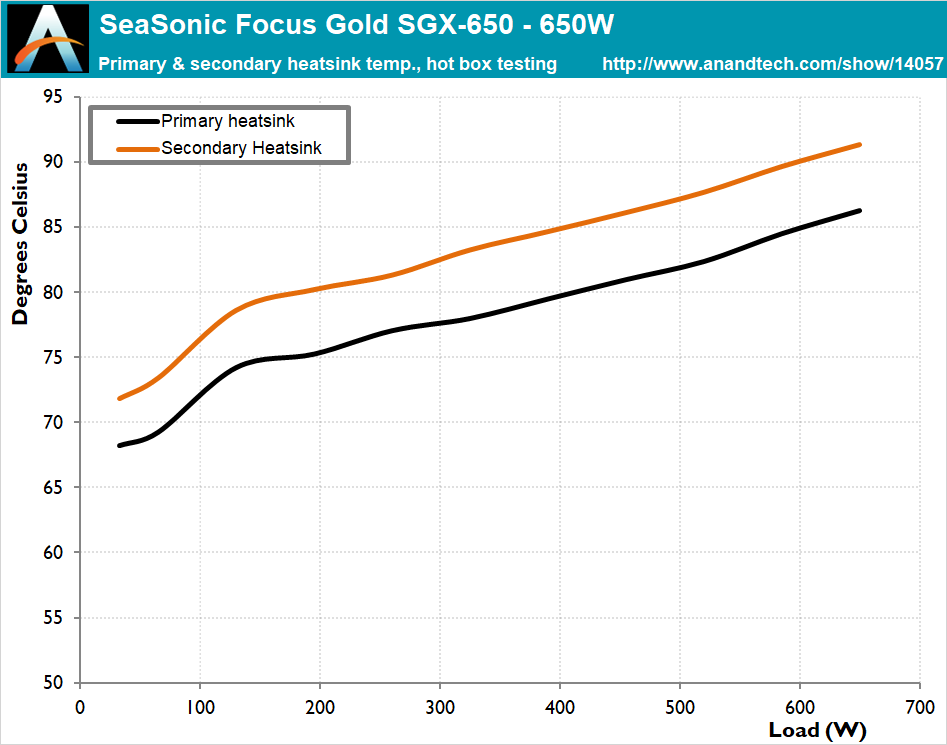The SeaSonic Focus Gold SGX-650 SFX Power Supply Review: Seasonic Starts off SFX With a Stunner
by E. Fylladitakis on March 7, 2019 8:30 AM EST- Posted in
- Cases/Cooling/PSUs
- Seasonic
- PSUs
- SFX
- Focus Gold SGX
Hot Test Results
Even though they complied with the design power quality guidelines, earlier SFX PSU designs often displayed poor power quality figures. However, more recent models, like the powerful SilverStone SX700-LPT and Corsair’s SF450, were greatly improved. The SeaSonic Focus Gold SGX-650 also delivers excellent power quality figures, comparable to those of the better ATX PSUs available.
Overall, filtering is very good on all lines. Our instruments recorded a maximum voltage ripple on the 12V line of only 26 mV under maximum load, with equally low voltage ripple figures on the secondary 3.3V and 5V lines. Voltage regulation is equally impressive, with the 12V maintaining a regulation of 1.0% within the nominal load range and even tighter regulation on the secondary lines.
| Main Output | ||||||||
| Load (Watts) | 131,66 W | 328,95 W | 489,82 W | 651,52 W | ||||
| Load (Percent) | 20,26% | 50,61% | 75,36% | 100,23% | ||||
| Amperes | Volts | Amperes | Volts | Amperes | Volts | Amperes | Volts | |
| 3.3 V | 1,78 | 3,38 | 4,45 | 3,38 | 6,67 | 3,35 | 8,89 | 3,34 |
| 5 V | 1,78 | 5,06 | 4,45 | 5,04 | 6,67 | 5,03 | 8,89 | 5,02 |
| 12 V | 9,6 | 12,15 | 24,01 | 12,14 | 36,01 | 12,05 | 48,02 | 12,02 |
| Line | Regulation (20% to 100% load) |
Voltage Ripple (mV) | |||||
| 20% Load | 50% Load | 75% Load | 100% Load | CL1 12V |
CL2 3.3V + 5V |
||
| 3.3V | 0,9% | 8 | 8 | 12 | 12 | 8 | 16 |
| 5V | 0,8% | 10 | 12 | 16 | 18 | 8 | 20 |
| 12V | 1,1% | 12 | 16 | 20 | 26 | 30 | 26 |
Looking at our hotbox test results, although the energy conversion efficiency of the SeaSonic Focus Gold SGX-650 does not drop significantly at first when it's inside the hotbox, there is a significant degradation once the load passes 550 Watts. This suggests that the PSU is finally getting thermally stressed at this point. The average efficiency reduction is 1.1%, with a drop of over 2.5% at 100% load, indicating significant thermal stress.
Meanwhile when it comes to cooling, when placed in our hotbox the fan in the SeaSonic Focus Gold SGX-650 started almost immediately after the PSU was powered-on. Noise levels were initially low but the dB(A) figures start climbing quickly when the load passed 300 Watts, with the PSU relying on the thin 120 mm fan for reliable operation. The fan reached its maximum speed with a 585 Watt load, struggling to maintain operational temperatures inside the PSU. Overall the fan does manage to keep the SeaSonic Focus Gold SGX-650 operational under these harsh operating conditions, if only barely.















38 Comments
View All Comments
Mr Perfect - Thursday, March 7, 2019 - link
Aww, this got my hopes up. The case I have only really works with SFX, not SFX-L and the headline called this a SFX. But hey, at least Seasonic is addressing the SFF market now. For ages they've just ignored the enthusiast SFF segment.abrowne1993 - Thursday, March 7, 2019 - link
Yep, the included Amazon link even mentions that it's SFX-L in the description. Should really be specified more clearly here.E.Fyll - Thursday, March 7, 2019 - link
Technically speaking, there is no SFX-L standard; that's just a term made up by SilverStone in 2013 (or 2014, my memory fails me) to describe their SFX units that were longer than 100 mm. I try and only use that term for SilverStone's products as it does not really apply to any other manufacturer (unless they choose to use the term themselves). SeaSonic even specifies that the form factor of the SGX-650 is Intel SFX in the product's manual, which this unit clearly is not fully compliant with. I cannot just baptize it whatever I want myself though, I can only state the facts, as I did on the second page of the review.piroroadkill - Friday, March 8, 2019 - link
Once enough products fall into a "made-up" standard, it becomes a de-facto standard. That's just how it is.Death666Angel - Friday, March 8, 2019 - link
That seems like a weird cop-out. All price comparison websites in Germany I know of have SFX-L as a seperate tab and they are not only comprised of Silverstone PSUs. Who do you want to standardize the form factor anyway? As far as I can see, Intel standardized ATX and Via standardized ITX. Are we supposed to just call ITX motherboards not made by Via as "smaller than ATX" motherboards in one paragraph and then just call them ATX in the rest of the review? And of course you can "baptize" the PSU however you want in a review you are writing yourself, just give sufficient explanation and people will more than likely thank you for being more clear than the manufacturer. If you just repeat the manufacturers talking points, reviews are useless. Call a duck a duck and not a somewhat misshapen swan. If someone is first to market with a good idea, they get to name it. If the idea is so good that others start to copy/adopt it, the name likely becomes the standard for the industry.DanNeely - Friday, March 8, 2019 - link
The thing is that despite Seasonic using the term on their amazon marketing it doesn't quite fit Silverstone's made up SFX-L standard, which is 130x125x63.5. Seasonic made this one 125x125x63.5; which is a hair smaller. Unless bastardized SFX PSUs start to proliferate (like long ATX supplies have) it probably doesn't matter since everything will either be the actual standard and only support 100mm long supplies or support the 130mm length Silverstone's marketing is calling SFX-LE.Fyll - Friday, March 8, 2019 - link
I believe that using your own example will help you understand why SFX-L is not a real standard.For something to classify as a "standard", it first has to have at least some basic specifications published (and adopted by a significant portion of the industry, but even just published would do). When VIA proposed the Mini-ITX standard, they published a lengthy white paper indicating its precise dimensions, expected energy requirements and dissipation, reference guides, etc. On the other hand, "anything longer than 100mm" does not classify as a standard at all and that is why SFX-L has not been adopted as a real standard by the industry. If it eventually will, it will have to clarify precisely how long the product should be.
And, as I said above, that term was just SilverStone's invention. I cannot pretend to know what their intentions were as a company but the fact is that it never actually was anything more than a marketing term. Besides, you are not calling ATX PSUs that are more than 140 mm "ATX-L", are you?
lmcd - Thursday, March 14, 2019 - link
Why put SFX at all if it's not valid SFX? Why not just put ATX, as it's more compliant with ATX than SFX? There's even an ATX bracket included, so it clearly can be used where an ATX PSU is expected.And that's why SFX-L is the correct moniker here.
Mr Perfect - Saturday, March 9, 2019 - link
That's interesting, today I learned that SFX-L isn't a defined standard.Samus - Monday, March 11, 2019 - link
The irony is the silverstone sfx unit you are mentioning is a 550w standard length SFX PSU, though not modular. Ironic, because this Seasonic - as good as it is, really can’t handle beyond 550w at high temps where the silverstone can.The silverstone is $40 less.